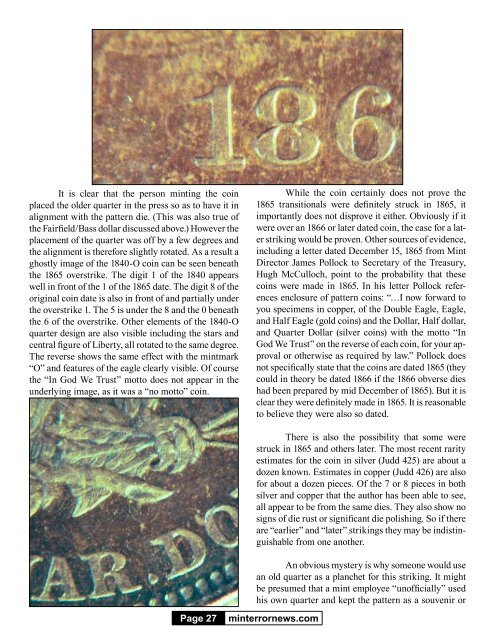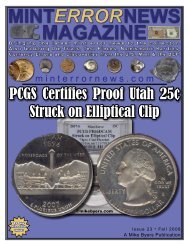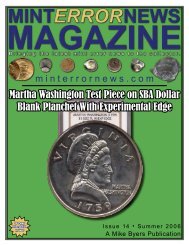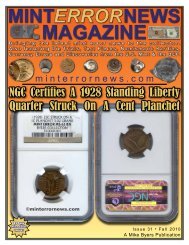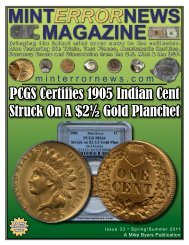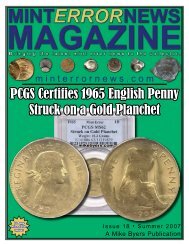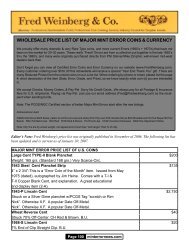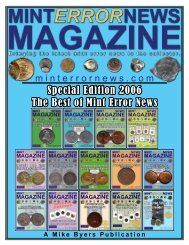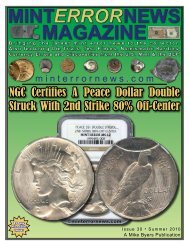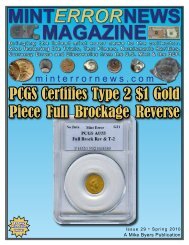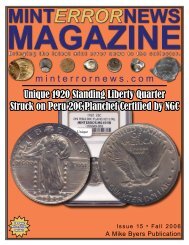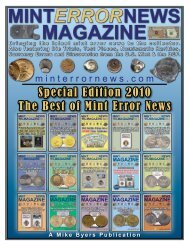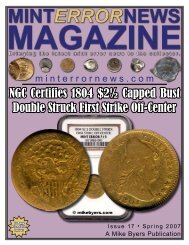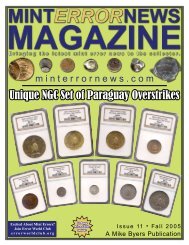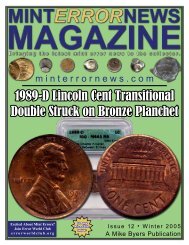J425/P497 Struck Over an 1840-O Quarterby William BierlyReprinted from uspatterns.comNEWLY DISCOVERED OVERDATE QUARTER MAY SHED LIGHT ON “IN GOD WE TRUST” TRANSI-TIONAL PATTERN QUESTION“What year was it really struck?” For the vastmajority of coins this is an irrelevant and perhaps sillyquestion. Just look at the date dummy!! Of course thereare famous exceptions. For example the dollars dated1804 were made decades after 1804, and only painfulresearch has revealed the likely actual years of theirmanufacture.The discovery of an 1865 pattern quarter struckover an 1840-O quarter may shed light on a series ofpattern coins where the actual date of striking haslong been a question. This is the series of Civil Warera coins related to the adoption of the motto “In GodWe Trust”. As for regular issue coins, the motto firstappeared on the 1864 Two Cent piece, and then wasadopted on the regular Quarter, Half Dollar, Dollar,Half Eagle, Eagle, and Double Eagle denominations in1866. However pattern coins with “In God We Trust”actually were struck on 1863 dated Two Cent pieces,1863, 1864, and 1865 dated Quarter, Half, and Dollardenominations, and on 1865 dated Half Eagles, Eagles,and Double Eagles in copper. These coins are called“Transitionals” as they are made/dated in years beforethey were adopted for regular coinage.It was long assumed that all of these “In GodWe Trust” patterns were truly struck in the same yearsthey were dated, but as research evolved, it was generallyconcluded that the 1863 and 1864 dated pieceswere probably struck in later years, perhaps in 1868or 1869 by mint employees for sale to collectors. Diecharacteristics and die rust on the reverses of the 1863and 1864 Quarters tend to reinforce this conclusion.However it was still widely believed that those dated1865 actually were from 1865. In fact the 1949 RedBook even included the 1865 “In God We Trust” HalfDollar as a regular issue.Then in 1977 one of these 1865 transitionals, anPage 261865 “In God We Trust” Dollar (listed as Judd no. 434in one of the standard pattern references, United StatesPattern, Experimental and Trial Pieces by J. HewittJudd) appeared in the Fairfield Collection sale. Thecataloguer, Bowers & Ruddy, noted that the coin wasover struck on an 1866 dollar! The coin was bought byHarry Bass Jr. and today resides in the Bass museumat the ANA in Colorado Springs. The eminent numismaticscholar Walter Breen summarized the impact ofthis discovery in his Complete Encyclopedia of U.S.and Colonial Coins published in 1988:“For generations the silver and gold coins (of1865) were accepted as true transitional issues . . . butin recent years their status has been flung into doubtbecause of a single silver dollar dated 1865 with motto,over struck on another dollar dated 1866.”Breen concluded that all of the 1865 “In GodWe Trust” pattern denominations were likely struck in1866 or later, largely it seems based on the evidence ofthis coin.Fast forward to the late 1990’s when closerinspection of the coin revealed that it was not struckover an 1866 dollar but rather over an 1853! So Breen’sevidence has been nullified and the question of whetherthe 1865 coins are “true transitionals” or later date productionsremains open.All of this background highlights the significanceof the discovery of another of the 1865 patternseries over struck on an earlier coin. In this case it is aQuarter (Judd 425) struck on an 1840-O Quarter. Thecoin, housed in a PCGS Proof 65 holder, was acquiredby the author as an upgrade to another Judd 425 in hiscollection. Upon close examination it was evident thatan 1840-O quarter had been used as the planchet forthe pattern.minterrornews.com
It is clear that the person minting the coinplaced the older quarter in the press so as to have it inalignment with the pattern die. (This was also true ofthe Fairfield/Bass dollar discussed above.) However theplacement of the quarter was off by a few degrees andthe alignment is therefore slightly rotated. As a result aghostly image of the 1840-O coin can be seen beneaththe 1865 overstrike. The digit 1 of the 1840 appearswell in front of the 1 of the 1865 date. The digit 8 of theoriginal coin date is also in front of and partially underthe overstrike 1. The 5 is under the 8 and the 0 beneaththe 6 of the overstrike. Other elements of the 1840-Oquarter design are also visible including the stars andcentral figure of Liberty, all rotated to the same degree.The reverse shows the same effect with the mintmark“O” and features of the eagle clearly visible. Of coursethe “In God We Trust” motto does not appear in theunderlying image, as it was a “no motto” coin.While the coin certainly does not prove the1865 transitionals were definitely struck in 1865, itimportantly does not disprove it either. Obviously if itwere over an 1866 or later dated coin, the case for a laterstriking would be proven. Other sources of evidence,including a letter dated December 15, 1865 from <strong>Mint</strong>Director James Pollock to Secretary of the Treasury,Hugh McCulloch, point to the probability that thesecoins were made in 1865. In his letter Pollock referencesenclosure of pattern coins: “…I now forward toyou specimens in copper, of the Double Eagle, Eagle,and Half Eagle (gold coins) and the Dollar, Half dollar,and Quarter Dollar (silver coins) with the motto “InGod We Trust” on the reverse of each coin, for your approvalor otherwise as required by law.” Pollock doesnot specifically state that the coins are dated 1865 (theycould in theory be dated 1866 if the 1866 obverse dieshad been prepared by mid December of 1865). But it isclear they were definitely made in 1865. It is reasonableto believe they were also so dated.There is also the possibility that some werestruck in 1865 and others later. The most recent rarityestimates for the coin in silver (Judd 425) are about adozen known. Estimates in copper (Judd 426) are alsofor about a dozen pieces. Of the 7 or 8 pieces in bothsilver and copper that the author has been able to see,all appear to be from the same dies. They also show nosigns of die rust or significant die polishing. So if thereare “earlier” and “later” strikings they may be indistinguishablefrom one another.An obvious mystery is why someone would usean old quarter as a planchet for this striking. It mightbe presumed that a mint employee “unofficially” usedhis own quarter and kept the pattern as a souvenir orPage 27minterrornews.com


